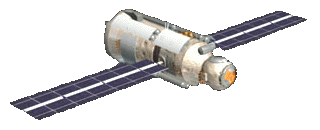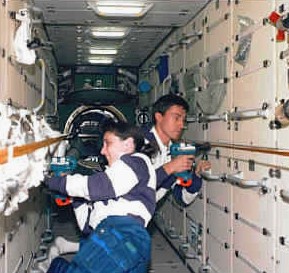
Zarya's forward port connects to Node 1. (Unity), via PMA-1. Zarya's rear port connects to Zvezda (SM). Zarya's bottom port connects to Rassvet.


Zarya's forward port connects to Node 1. (Unity), via PMA-1. Zarya's rear port connects to Zvezda (SM). Zarya's bottom port connects to Rassvet.

The Russian built, U.S. owned, Functional Cargo Block, (FGB in Russian), is also known as the Zarya Control Module. It was the first component of ISS launched into orbit.

Zarya, which means 'Sunrise' in Russian, is a descendant of the TKS spacecraft designed for the Russian Salyut program.
Zarya was initially self-contained, providing battery power, fuel storage, communications, attitude control functions and rendezvous and docking capability for Russian space vehicles. It is now primarily used for storage inside the pressurized section and in the externally mounted fuel tanks.
The module which was based on the modules of Mir, is now used primarily for storage and propulsion and has an operational lifetime of at least 15 years. The Russian Multi purpose Modules planned for the ISS will be based on the FGB-2, a spare developed as a backup.

Zarya's aft port is connected permanently to the Service Module (Zvezda) and Zarya's forward port is connected permanently to Node 1 (Unity). A pressurised corridor runs along Zarya's axis to provide access from Zvezda to Unity.
The attitude control system for the module includes 24 large steering jets and 12 small steering jets. Before the Service Module, Zvezda was attached, two large engines on Zarya were available for re-boosting the spacecraft and making major orbital changes.
Reference: Wikipedia - Zarya | Russian Space Web - Zarya
The Russian Mini-Research Module 1 [MRM-1] (Rassvet) is permanently docked to Zarya's nadir (bottom) port. Rassvet is primarily used for cargo storage and as a mini-research laboratory. It also provides an additional docking port for Russian Soyuz TM and Soyuz TMA piloted spacecraft and Russian un-piloted Progress supply spacecraft. Zarya is part of the Russian Segment of the Station.
Zarya was built for NASA at Khrunichev State Research and Production Space Center, (KhSC), in Moscow under a subcontract to The Boeing Company. Construction began in December 1994. It was shipped to the Baikonur Cosmodrome, Kazakhstan, launch site to begin launch preparations in January 1998.

Zarya was launched on November 20th. 1998 on a Russian Proton rocket from Baikonur in Russia.
During launch, the module's systems were in an idle mode to conserve battery power.
When it reached an initial 220.4 by 339.6 kilometers elliptical orbit Zarya was separated from the Proton's third stage and a set of pre-programmed commands automatically activated the module's systems and deployed the solar arrays and communications antennas.

After several days of operational tests, the module was commanded to fire its engines and circularize its orbit at an altitude of about 386.2 kilometers (240 statute miles). This is the orbit at which Shuttle Endeavour will make rendezvous and capture Zarya to attach it to the Unity Node.
Zarya activation was completed by crew members of the U.S. Space Shuttle Endeavour on mission STS-88 [Flight 2A]. This mission delivered and installed the Unity Node 1. which was berthed to the forward end of Zarya.
Zarya was entered for the first time in space on Dec. 10, 1998 by the Endeavour crew.
Environment: Pressurised
Length: 12.99 m
Diameter: 4.1 m at widest point
Mass: 24,968 kg
Pressurized Volume: 71.5 cu m
Fuel Tanks [16] 6 tons of propellant
Batteries [6]: nickel-cadmium
Solar Arrays [2]
- Length: 10.7 m
- Width: 3.4 m
- Power: 3 kw average